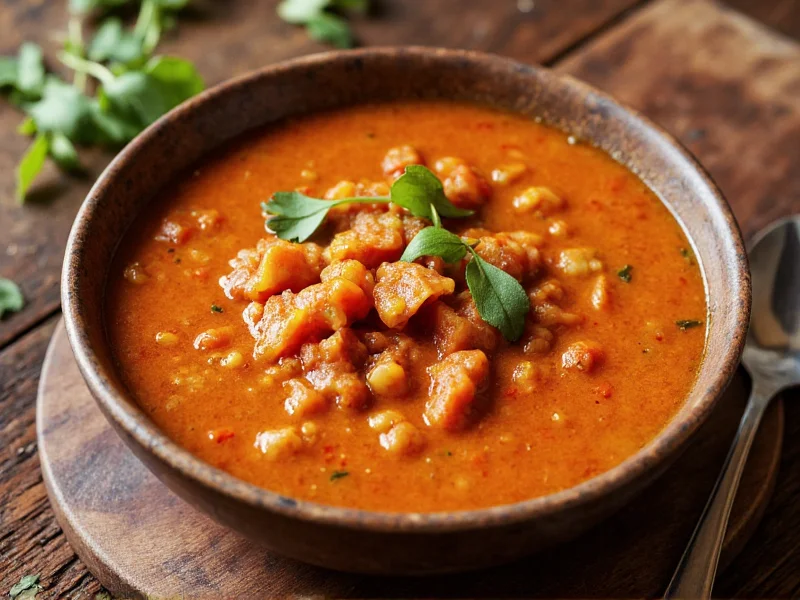Spicy soups represent one of the world's most universally beloved comfort foods, transcending cultural boundaries while maintaining distinctive regional identities. The magic of these dishes lies not just in their heat but in the complex interplay of flavors that balance fiery elements with complementary ingredients. Understanding what makes a truly exceptional spicy soup requires examining both the science of spiciness and the cultural traditions that have refined these recipes over centuries.
The Science Behind Spicy Soup Sensation
Capsaicin, the compound responsible for chili heat, interacts with pain receptors in our mouths, creating that familiar burning sensation. Interestingly, this reaction triggers endorphin release, explaining why many people develop a craving for spicy foods. The Scoville scale measures chili heat intensity, ranging from mild bell peppers (0 SHU) to extreme varieties like the Carolina Reaper (1.4-2.2 million SHU). When crafting authentic spicy soup recipes, understanding these heat levels helps balance flavors without overwhelming the palate.
Regional variations in spice tolerance demonstrate fascinating biological adaptation. Populations with long histories of chili consumption, such as in Thailand or Mexico, often develop higher tolerance through regular exposure. This biological adaptation influences traditional spicy soup preparation methods, with cultures naturally developing techniques to maximize flavor while managing heat levels.
Global Traditions of Spicy Soup Mastery
Every major culinary tradition features distinctive spicy soup variations, each reflecting local ingredients and cultural preferences. The following table highlights notable examples of traditional spicy soups across different regions:
| Region | Signature Spicy Soup | Key Heat Elements | Distinguishing Features |
|---|---|---|---|
| Thailand | Tom Yum | Fresh bird's eye chilies, chili paste | Tangy lemongrass and lime leaf base with shrimp or chicken |
| Mexico | Pozole | Guajillo and ancho chilies | Hominy-based with slow-cooked pork and garnish bar |
| Sichuan, China | Hot Pot | Sichuan peppercorns, dried chilies | Mala (numbing-spicy) sensation with communal cooking |
| Nigeria | Pepper Soup | Scotch bonnet peppers, utazi leaves | Medicinal properties with fish or goat meat options |
| Korea | Kimchi Jjigae | Fermented kimchi, gochugaru | Deep umami from aged kimchi with tofu and pork |
Health Benefits Beyond the Heat
Research indicates that regularly consuming spicy soups provides several health advantages. Capsaicin stimulates thermogenesis, potentially boosting metabolism by up to 5% and increasing fat oxidation by 16%. The anti-inflammatory properties of chili compounds may help reduce chronic inflammation markers. Many traditional spicy soup recipes incorporate additional health-promoting ingredients like garlic, ginger, and turmeric that work synergistically with chili components.
Spicy soups also offer respiratory benefits, particularly during cold season. The steam combined with capsaicin helps clear nasal passages and reduce sinus pressure. This explains why cultures worldwide have developed spicy soup remedies for colds and congestion. The hydration from broth-based spicy soups further supports immune function during illness.
Mastering Spice Balance in Soup Preparation
Creating exceptional spicy soups requires understanding how to layer heat effectively. Professional chefs recommend adding chili elements at different cooking stages: dried chilies early for deep flavor foundation, fresh chilies mid-cooking for brighter heat, and chili oils or fresh peppers at the end for aromatic punch. Acidic components like lime juice or vinegar help balance intense heat while enhancing overall flavor complexity.
When adjusting spice levels for different palates, consider these professional techniques:
- Add dairy or coconut milk to moderate heat without losing flavor
- Incorporate natural sweetness from roasted vegetables to counterbalance spice
- Use toasted spices to deepen flavor without increasing heat intensity
- Offer customizable heat levels through garnish bars with fresh chilies
Cultural Significance of Spicy Soups Worldwide
Spicy soups often hold deep cultural significance beyond mere sustenance. In many Asian traditions, spicy broths form the foundation of medicinal food practices, with specific ingredients chosen for their healing properties. Mexican pozole carries ceremonial importance, traditionally prepared for celebrations and special occasions. Nigerian pepper soup frequently appears in cultural rituals and is believed to have protective properties.
The communal aspect of spicy soups deserves special attention. Many cultures serve these dishes family-style, encouraging sharing and social bonding. The shared experience of managing heat levels creates natural conversation and connection among diners. This social dimension explains why spicy soups remain popular choices for gatherings and celebrations worldwide.
Practical Enjoyment of Spicy Soups
Maximizing your spicy soup experience involves more than just preparation. Pairing considerations significantly impact enjoyment—cooling elements like yogurt or rice help balance intense heat. Temperature matters too; slightly cooler soups allow more nuanced flavor appreciation than piping hot versions that overwhelm the palate.
For those building spice tolerance, gradual exposure through regularly consuming mildly spicy soups proves more effective than occasional extreme heat experiences. Many cultures traditionally introduce children to spice through mild soup versions, developing tolerance naturally over time. Understanding these cultural approaches helps newcomers appreciate spicy soups without discomfort.











 浙公网安备
33010002000092号
浙公网安备
33010002000092号 浙B2-20120091-4
浙B2-20120091-4